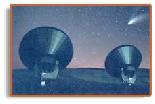
|
Recent Results
|
Recent Results
| Annual Reports
| NewsLetters
| Interferometry School
| Technical Reports
|
 |
|
Recent scientific results from the IRAM observatories are issued on
this page when they are made available by the authors. Interested
readers are asked to contact the investigators for more details. Only
the home institute of the principal investigator is listed.
|
PR 0402/09
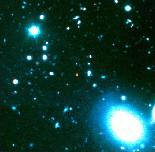
|
Infant Galaxies: Small and Hyperactive
Fabian Walter, Max-Planck-Institut für Astronomie Heidelberg (Germany) ;
Dominik Riechers du Max-Planck-Institut für Astronomie Heidelberg (Germany) and California Institute of Technology Pasadena (USA) ;
Pierre Cox and Roberto Neri, Institut de Radioastronomie Millimétrique Grenoble (France) ;
Chris Carilli, National Radio Astronomy Observatory Socorro (USA) ;
Frank Bertoldi, Argelander Institut für Astronomie Bonn (Germany) ;
Axel Weiss, Max-Planck-Institut für Radioastronomie Bonn (Germany) ;
Roberto Maiolino, Istituto Nazionale di Astrofisica, Osservatorio Rome (Italy)
When galaxies are born, do their stars form everywhere at once, or
only within a small core region? Recent measurements provide the first
concrete evidence that star-forming regions in infant galaxies are
indeed small - but also hyperactive, producing stars at
astonishingly high rates.
This is the conclusion drawn from recent observations of one of the
most distant known galaxies: a so-called quasar with the designation
J1148+5251. Light from this galaxy takes 12.8 billion years to reach
Earth; in turn, astronomical observations show the galaxy as it
appeared 12.8 billion years ago, providing a glimpse of the very early
stages of galactic evolution, less than a billion years after the Big
Bang.
The observers, an international team of researchers led by scientists
from the Max Planck Institute for Astronomy, made use of the IRAM
Interferometer, a German-French-Spanish radio telescope, to obtain
images of a very special kind: They recorded the infrared radiation
emitted by J1148+5251 at a specific frequency associated with ionized
carbon atoms, which is a reliable indicator of ongoing star
formation. The resulting images show sufficient detail to allow, for
the first time, the measurement of the size of a very early
star-forming region. With this information, the researchers were able
to conclude that, at the time, stars were forming in the core region
of J1148+5251 at record rates - any faster, and star formation
would have been in conflict with the laws of physics.
The results will be published in the February 5 issue (Volume 457,
No. 7230) of the journal Nature.
For more details see the full press releases on English,
French and
German.
|
PR 1216/08
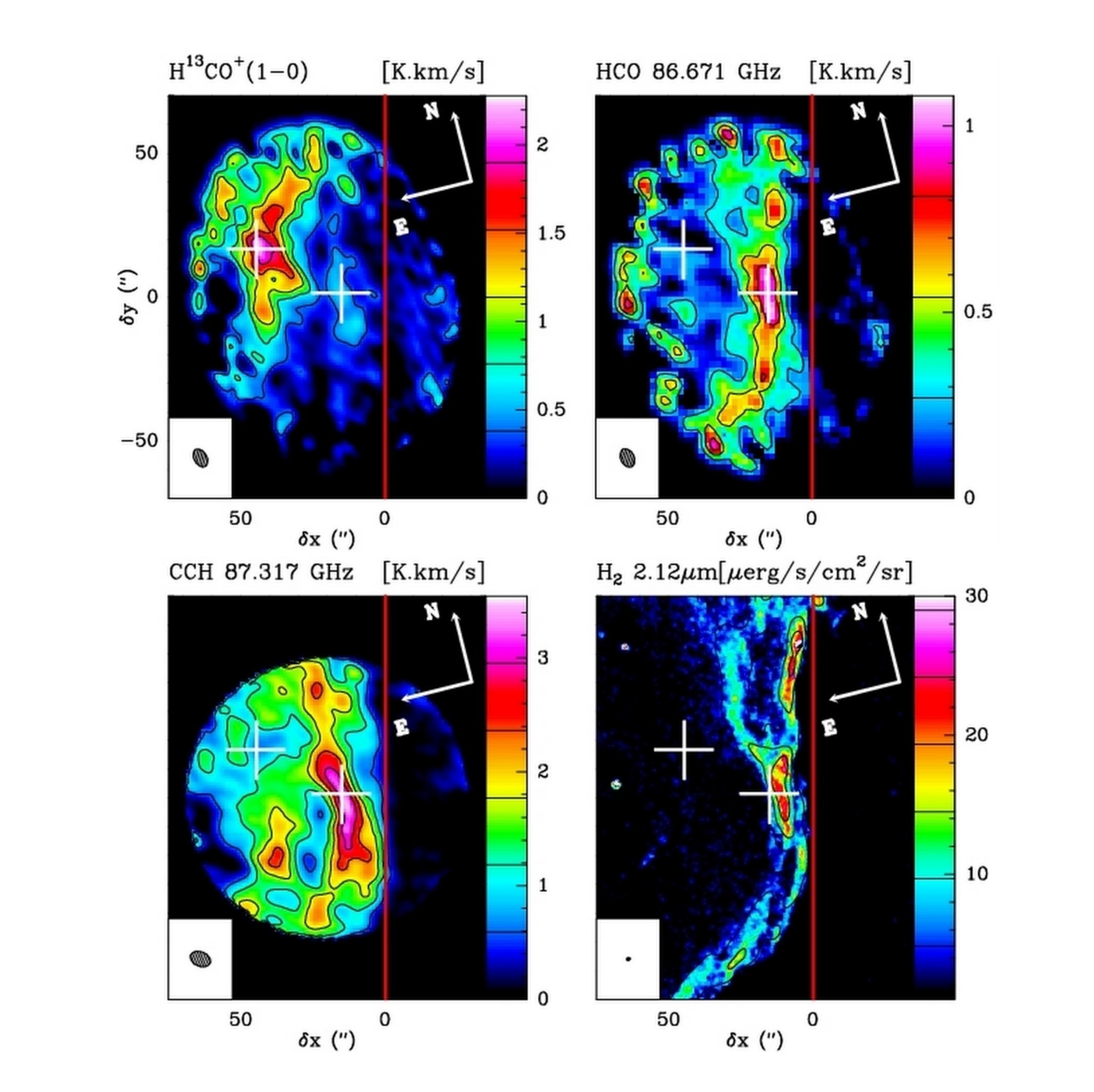
|
HCO mapping of the Horsehead : Tracing the illuminated dense
molecular cloud surfaces
M. Gerin,
J.R. Goicoechea, J. Pety,
P. Hily-Blant Laboratoire de
Radioastronomie ENS, Paris, France
Stellar UV radiation is one important feedback mechanism for
regulating star formation. It dissociates molecules and ionizes and
heats the gas and the dust in photon dominated regions (PDRs). Star
formation is revealed by this interaction, as it produces strong
emission lines from the UV-excited gas. The investigation of a variety
of tracers of the physics and chemistry of PDRs is a prerequisite for
understanding the large scale roles of these feedback mechanisms. PDR
models are used to understand the evolution of the UV irradiated
matter both in our Galaxy and in external galaxies.
The illuminated edge of the Horsehead nebular, at only 450 pc
distance, is one of the best studied PDRs. High sensitivity and
spatial resolution maps of the horsehead nebula have been obtained
with the IRAM 30m and PdBI (Gerin et
al. 2008). These maps show that the formyl radical HCO is
confined in a thin filament which delineates the UV illuminated edge
of the nebula. The formyl radical HCO therefore appears to be a tracer
of PDR at millimeter wavelengths, which could be used to trace UV
dominated environments in the local and distant universe, whatever the
visual extinction. Although state of the art chemical models fail to
reproduce the observed abundance, two promising paths have been
proposed by Gerin et
al. 2008, which should be further investigated.
The inset shows high angular
resolution maps of the integrated intensity of
H13CO+, HCO, CCH and vibrationally excited
H2 emission. The PDR edge, delineated by the red vertical
line, is illuminated by σ Ori lying to the right.
For more details see arXiv:0811.1470
|
PR 1212/08
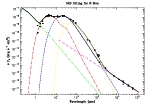
|
Photoevaporating circumstellar disks around Herbig Be stars
T. Alonso-Albi, A. Fuente, R. Bachiller, R. Neri, P. Planesas, L.Testi, O. Berné C. Joblin
Observatorio Astronomico National, Madrid, Spain
A search for circumstellar disks around Herbig Be stars has been
carried out using the NRAO Very Large Array (VLA) and the IRAM Plateau
de Bure (PdB) interferometers. Thus far, we have observed 6 objects (R
Mon, MWC 1080, MWC 137, MWC 297, Z CMa and LKHα215) with 4
successful detections (R Mon, MWC 1080, MWC 297, Z CMa).
The disk mass is usually only a small percentage (less than 10%) of
the mass of the whole envelope in HBe stars, in contrast to what is
usually found in the lower mass T Tauri and Herbig Ae stars. In
addition, although massive disks (~0.1 Msun) are found in
very young objects (~104 yr), the masses of the disks
around Herbig Be stars are usually 5-10 times lower than those around
lower mass stars (<0.01 Msun). High angular resolution and
very sensitive interferometric observations are required to detect
their emission at millimeter wavelengths. We propose that disk
photo-evaporation is responsible for this behavior. In Herbig Be stars
the UV radiation disperses the gas of the outer disk on a time-scale
of a few 105 yr. Once the outer part of the disk is gone,
the entire gaseous disk is photo-evaporated in a very short time-scale
(~105 yr) and only a small dusty disk composed of large
grains remains. The whole process completes before the envelope is
blown away.
The observed SED and model
predictions for R Mon: the different emission components that
contribute to the SED as predicted by our model are drawn in different
colours. The emission of the star itself is drawn in green. The disk
emission is separated in three components: inner rim emission
(magenta), surface layer emission (red) and the midplane emission
(blue). Note that the disk around R~Mon is fitted without the presence
of an inner rim. The emission from the envelope is drawn in
yellow. The free-free emission is shown in magenta. The disk emission
and the disk+envelope emission appear as a two continuous black
lines.
For more details see arXiv:0812.1636
|
|
PR 1125/08
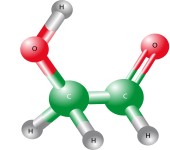
|
First detection of glycolaldehyde outside the Galactic Center
M.T. Beltran,
C. Codella, S. Viti, R. Neri, R. Cesaroni
Universitat de Barcelona-CSIC, Barcelona, Spain
Press Release (English).
Glycolaldehyde is the simplest of the monosaccharide sugars and is
directly linked to the origin of life. We report on the detection of
glycolaldehyde (CH2OHCHO) towards the hot molecular core G31.41+0.31
through IRAM PdBI observations at 1.4, 2.1, and 2.9 mm.
The CH2OHCHO emission comes from the hottest (> 300 K) and
densest (> 2 x 108 cm-3) region closest (<
104 AU) to the (proto)stars. The comparison of data with
gas-grain chemical models of hot cores suggests for G31.41+0.31 an age
of a few 105 yr.
We also show that only small amounts of CO need to be processed on
grains in order for existing hot core gas-grain chemical models to
reproduce the observed column densities of glycolaldehyde, making
surface reactions the most feasible route to its formation.
For more details see ApJ, 690, L93
|
|
PR 0403/08
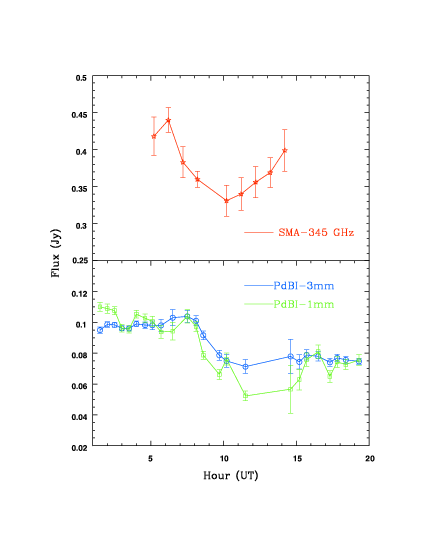
|
Global multi-wavelength campaign on M81* confirms accretion mass
scaling from stellar to galactic black holes
S. Markoff, M. Novak, A. Young, H.L. Marshall, C.R. Canizares, A. Peck, M. Krips, G. Petitpas, R. Schödel, G.C. Bower, P. Chandra, A. Ray, M. Muno, S. Gallagher, S. Hornstein, C.C. Cheung Sterrenkundig Instituut "Anton Pannekoek", Amsterdam, The Netherlands
Evidence has been steadily accumulating in the last years that
accretion and emission processes related massive black holes are
fundamentally similar to the physics in stellar mass black holes.
However, in order to compare the low/hard state of X-ray binaries to
galactic black holes, it is necessary to observe sources that accrete
at highly sub-Eddington rates. Those sources are rare targets because
of their intrinsic faintness. An additional challenge is that -
because of the strong variability of the targets - multi-wavelength
observations of these objects must be performed (quasi-)
simultaneously. Sagittarius A*, the black hole at the center of the
Milky Way used to be the only such object with reliable observations
from radio to X-ray wavelengths.
An unprecedented coordinated multi-wavelength campaign focused on the
low-luminosity active galactic nucleus in M81* from February to Augst
2005. Centered around five epochs of Chandra X-ray observations, this
global campaign included the Giant Meterwave Radio Telescope, the Very
Large Array and Very Large Baseline Array, the Plateau de Bure
Interferometer at IRAM, the Submillimeter Array and Lick
Observatory.
We compare the obtained spectrum of M81* to our Galactic center weakly
active nucleus Sgr A*, which has undergone similar campaigns, as well
as to weakly accreting X-ray binaries in the context of
outflow-dominated models. We find that the physics of weakly-accreting
black holes scales predictably with mass, and that the exact same
model which successfully describes hard state X-ray binaries applies
to M81*, with very similar physical parameters.
For more details see astro-ph/0804.0344
|
|
PR 0326/08
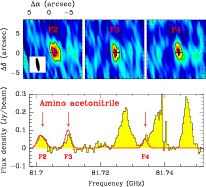
|
Detection of amino acetonitrile in Sgr B2(N)
A. Belloche, K.M. Menten, C. Comito,
H.S.P. Müller, P. Schilke, J. Ott, S. Thorwirth, C. Hieret Max-Planck-Institut
für Radioastronomie (MPIfR), Bonn, Germany
Press Release (English) issued by the Public Relation Office of the MPIfR
Press Release (French) issued by the Public Relation Office of the CNRS
We discovered the organic molecule amino acetonitrile
(NH2CH2CN) in the hot dense core Sgr B2(N) with
the IRAM 30m telescope, the IRAM Plateau de Bure interferometer, and
the Australia Telescope Compact Array. Amino acetonitrile is a
molecule chemically related to - and probably a direct precursor of -
glycine (NH2CH2COOH), the simplest amino acid,
which has not yet been found in space.
We carried out a complete survey of Sgr B2(N) between 80 and 116 GHz
in the 3mm atmospheric window with the IRAM 30m telescope, plus
partial surveys at 2 and 1.3mm. At 3mm, we detected about 3700 lines
of which we have identified about 60% so far. In this forest of lines,
we were able to identify 51 weak features at the frequencies predicted
for amino acetonitrile with intensities compatible with a unique
rotation temperature of 100K. Nine features were followed-up with the
PdBI and the ATCA and found to be emitted by the same compact (~2'')
region, consistent with emission from a unique molecule. The figures
show the spectrum containing three features detected with the PdBI
along with their maps of integrated intensity. The red spectrum is a
model prediction in the LTE approximation.
Based on our detection of amino acetonitrile and a comparison to the
pair methylcyanide/acetic acid both detected in our survey, we suggest
that the column density of glycine in Sgr B2(N) is well below the
current best upper limits and most likely below the confusion limit in
the 3mm range.
For more details see A&A
|
|
PR 0130/08
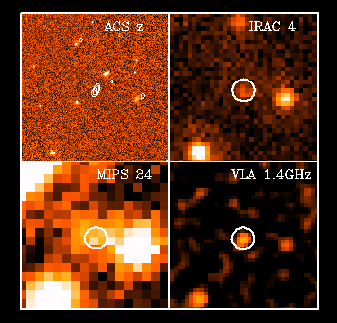
|
Interferometric Detections of GOODS 850-5 at 1 mm and 1.4 GHz
H. Dannerbauer, F. Walter, G. Morrison
Max-Planck-Institut
für Astronomie (MPIA), Heidelberg, Germany
Using the Plateau de Bure Interferometer at 1.25 mm we obtained (at
subarcsecond accuracy) the position of the submillimeter bright source
GOODS 850-5 (also known as GN 10) in the GOODS-North field (MM
J123633+6214.1, flux density: S1.25 mm = 5.0 ± 1.0
mJy). At the time of proposing the PdBI observations (September 2005)
this source was undetected at 1.4 GHz down to 40 µJy, thus being a
good candidate for lying at very high redshift (z~4).
Interestingly, this submillimeter bright galaxy (SMG) is undetected in
deep ACS imaging (limit: i775=28.4mag), faint in Spitzer
IRAC and MIPS 24 µm; and its position is coincident with the
position found in recent submillimeter mapping obtained at the SMA by
Wang and coworkers. In the meantime deeper VLA observations were
obtained from us as well, resulting in a solid detection
(S20cm=34.4 ± 4.2 µJy; in agreement with a 3
sigma detection previously reported by Pope and coworkers) and
consistent with the PdBI position.
We apply different photometric redshift estimators using measurements
of the dusty, mid/far-infrared part of the SED and derive a redshift
z~4. GOODS 850-5 represents one of the few solid candidates of a high-z
(z > 3) SMG that contribute to the cosmic star formation rate density
at early cosmic times.
In the figure we show 20'' x 20'' ACS z850, IRAC 8.0
µm, MIPS 24 µm, and radio images of the field of MM
J123633+6214.1. PdBI contours of 1.25 continuum emission of MM
J123633+6214.1 are overlaid on the ACS z850 image and start
at 3 mJy with steps of 1 mJy; 3.0'' circles are drawn on the PdBI
position in the IRAC 8.0 µm, MIPS 24 µm, and radio images.
For more details see ApJ, Vol 673, 2008, L127-L130
|
|
PR 1206/07
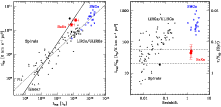
|
Vigorous star formation with low efficiency in massive disk galaxies at z=1.5
E. Daddi, H. Dannerbauer, D. Elbaz, M. Dickinson,
G. Morrison, D. Stern, S. Ravindranath
Service d'Astrophysique (CEA Saclay), France
Plateau de Bureau Interferometric observations have revealed for the first time
a new galaxy formation mode in the distant Universe. Two z=1.5 galaxies were observed in their
gas cooling CO emission lines, selected to lie in the mass-star formation rate
correlation at their redshift, thus being representative of massive high-z
galaxies. Both sources were detected with high confidence, despite possible expectations
based on existing correlations between CO and FIR luminosities of galaxies.
These disk-like galaxies are borderline ULIRGs but with
star formation efficiency similar to that of local spirals,
and an order of magnitude lower than that in submm galaxies.
This suggests a CO to total gas conversion factor similar to local
spirals, gas consumption timescales approaching 1 Gyr or longer and
molecular gas masses reaching ~1011Msun, comparable to
or larger than the
estimated stellar masses.
These results support a major role of in situ gas
consumption over cosmological timescales and with relatively low
star formation efficiency, analogous to that of local spiral disks,
for the formation of today's most massive galaxies and their central black
holes.
Given the high space density of similar galaxies,
~10-4 Mpc-3, this implies a widespread presence of gas rich
galaxies in the early Universe, many of which might be
within reach of detailed investigations of current and planned
facilities.
The figure on the left shows the relation between FIR and CO
luminosities of local and distant galaxies, compared to the data for
the 2 newly observed BzK galaxies at z=1.5. The maps and spectra of the 2 newly observed
BzK galaxies can be viewed as well.
For more details see astro-ph/0711.4995 (ApJL, in press)
|
|
PR 0531/07
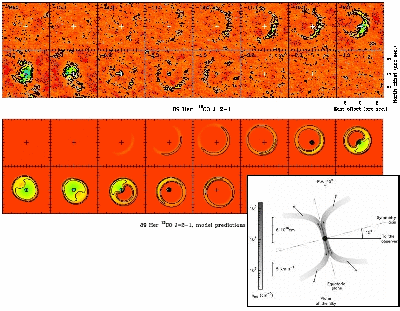
|
The nebula around the post-AGB star 89 Herculis
V. Bujarrabal, H. Van Winckel, R. Neri, J. Alcolea, A. Castro-Carrizo, P. Deroo
Observatorio
Astronomico Nacional, Spain
We have performed high-resolution PdBI maps of CO J=2-1 and 1-0 of
89 Her, using in particular the newly extended A configuration. We
also present N-band interferometric data on the extent of the hot dust
emission, obtained with the VLTI. 89 Her is a well know post-AGB star,
surrounded by a (protoplanetary) nebula that has been proposed to
harbor an inner rotating disk. The presence of keplerian disks in
protoplanetary nebulae is important, since they could explain the
ejection of collimated, energetic jets, characteristic of post-AGB
stars. However, the study of the dynamics of such structures needs CO
mapping with very high resolution, and they had been only confirmed in
one post-AGB object (the Red Rectangle).
Our CO maps show two nebular components: (a) an extended
hour-glass-like structure, with expansion velocities of ~7 km/s,
and (b) an unresolved very compact component, smaller than
~0.4'' and with a low total velocity dispersion of ~5 km/s. We
cannot determine the velocity field in the compact component, but we
argue that it can hardly be in expansion, since this would require too
recent and too sudden an ejection of mass. On the other hand, assuming
that this component is a keplerian disk, we derive disk properties that
are compatible with expectations for such a structure; in particular,
the size of the rotating gas disk should be very similar to the extent
of the hot dust component from our VLTI data. We therefore conclude
that it is probably a keplerian disk with a very small extent (diameter
≤ 1015 cm).
In the figure we show the J=2-1 maps, together with a description of
our nebula model and its predictions; the compact unresolved component
is represented in the model by the black circle.
For more details see astro-ph/0703718 (A&A, in press)
|
|
PR 0402/07
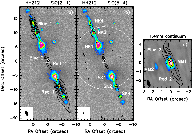
|
A highly-collimated SiO jet in the HH212 protostellar outflow
C. Codella,
S. Cabrit, F. Gueth, R.Cesaroni, F. Bacciotti, Lefloch, B., McCaughrean, M.J.
INAF - Istituto di Radioastronomia, Italy
We mapped the inner 40'' of the HH212 Class 0 outflow in
the SiO(2-1), (5-4) lines in the mm and continuum using the PdB
interferometer in its extended configurations. The unprecedented
angular resolution (down to 0.34'') allows accurate comparison with
a new, deep H2 image obtained at the VLT.
The SiO emission is confined to a highly-collimated bipolar jet
along the outflow main axis. It can be traced down to 500 AU of the driving source, in a region that is heavily obscured in the H2 images. Where both species are detected, SiO shows the same overall kinematics and
structure as H2, indicating that
both molecules are tracing the same material. Transverse cuts reveal no
velocity gradient compatible with jet rotation above 1 km s-1
on a scale ~0.3'', in contrast to
previous claims in H2. We find evidence that
the high-velocity SiO gas is not tracing a wide-angle
wind but is already confined inside a narrow cone of
semi-opening angle <6o at ≤500AU from the protostar.
For more details see
Astronomy and Astrophysics, Volume 462, 2007, L53 - L57
|
|
PR 0330/07
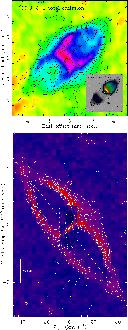
|
13CO observations of the pre-Planetary Nebula
M1-92 in the newly extended configurations
J. Alcolea,
R. Neri, V. Bujarrabal Observatorio
Astronomico Nacional, Spain
When solar-mass type of stars run out of nuclear fuel at their
cores, the grow enormously becoming red giants. In this phase of
their lives, stars pulsate and loss a good deal of their mass
trough a steady spherical wind of dust and gas, which forms a
circumstellar envelope (CSE). As the stars evolve, the mass loss
becomes higher and the circumstellar envelope thicker. At some
point, the mass loss is so large that the whole stellar mantle is
lost and the hot tiny stellar core becomes exposed. The star
floods the envelope with ultraviolet photons, that destroy
molecules and ionize atoms forming a planetary nebulae
(PN). However CSEs are roughly spherically symmetric whereas PNe
are not. How this fantastic metamorphosis may happen is one of the
mysteries in stellar evolution. This transformation occurs in less
than 1000 yr, during the so called pre-Planetary Nebula (pPN)
phase. Because these phase is brief, pPNe are rare and located
rather far away from us, and so to study these transforming
envelopes sub-arcsecond resolution is mandatory.
M1-92 is one of these rare objects that have been observed and
studied in detail. Taking advance of the new extended
configurations of the IRAM Plateau de Bure interferometer, we have
conducted observations of 13CO J=2-1 in this source,
which have been merged with previously published data, yielding
the most sensitive maps ever obtained in this transition and a
spatial resolution of about 0.3''. On the top we show the map of
the total integrated emission. The inset shows the continuum HST
image at 547 nm. Tick marks are the same in the two plots. On the
bottom we show the position vs. velocity diagram for a cut along
the symmetry axis of the nebula. In the central part we have used
data from the new-A configuration only. This plot also represents
the structure of the nebula, for which the linear scale is given
by the vertical bar. From these results we conclude that this 1
solar mass nebula was formed 1000 yr ago as the result of a
magneto-rotational driven explosion, probably induced by the
presence of a low-mass stellar companion.
For more details see
astro-ph/0701455 (A&A in press)
|
|
PR 0228/07
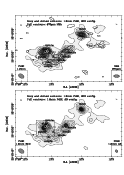
|
Interferometric multi-wavelength (sub)millimeter continuum study of the young high-mass protocluster IRAS 05358+3543
H. Beuther, S. Leurini, P. Schilke, F. Wyrowski, K.M. Menten, Q. Zhang,
Max-Planck-Institut für Astronomie, Heidelberg, Germany
Aims: We study the small-scale structure of massive star-forming
regions through interferometric observations in several (sub)mm
wavelength bands. These observations resolve multiple sources, yield
mass and column density estimates, and give information about the
density profiles as well as the dust and temperature properties.
Methods: We observed the young massive star-forming region
IRAS05358+3543 at high-spatial resolution in the continuum emission
at 3.1 and 1.2mm with the Plateau de Bure Interferometer, and at 875
and 438µm with the Submillimeter Array. The observations are
accompanied by VLA 3.6cm archival continuum data.
Results: We resolve at least four continuum sub-sources that are
likely of protostellar nature. Two of them are potentially part of a
proto-binary system with a projected separation of 1700AU.
Additional (sub)mm continuum peaks are not necessarily harboring
protostars but maybe caused by the multiple molecular outflows. The
spectral energy distributions (SEDs) of the sub-sources show several
features. The main power house mm1, which is associated with CH3OH
maser emission, a hypercompact HII
region and a
mid-infrared source, exhibits a typical SED with a free-free emission
component at
cm and long mm wavelengths and a cold dust component in the (sub)mm
part of the spectrum (spectral index between 1.2mm and 438µm
α ~3.6).
The free-free emission corresponds to a Lyman
continuum flux of an embedded 13Msun B1 star. The coldest
source of the region, mm3, has α~3.7
between 1.2mm and
875µm, but has lower than expected fluxes in the shorter
wavelength 438µm band. This turnover of the Planck-function sets
an upper limit on the dust temperature of mm3 of approximately
20K. The uv-data analysis of the density structure of individual
sub-cores reveals distributions with power-law indices between 1.5 and
2. This resembles the density distributions of the larger-scale
cluster-forming clump as well as those from typical low-mass
cores.
For more details see
Astronomy and Astrophysics, Volume 466, Issue 3, May II 2007, pp. 1065-1076
|
|
PR 0216/07

|
Multi-epoch dual frequency mm-observations of the nucleus of M81
R. Schödel, M. Krips, S. Markoff, R. Neri, A. Eckart,
I. Physikalisches Institut Universität zu Köln, Köln, Germany
While there is a fairly good understanding of the physical mechanisms
at work in bright AGN, where accretion is thought to be related to
thin, fairly cool radiatively efficient disks, there are still many
open questions concerning the physical mechanisms at work in Low
Luminosity AGN that accrete in the extreme sub-Eddington regime. The
primary testbed for these theories is Sagittarius A*, the
supermassive black hole at the center of the Milky Way that radiates
at only about 10-9 times its Eddington luminosity. In order to base
existing theories on a broader observational basis, it is important
to extend our insights from this system to other objects and build a
bridge toward higher luminosity galactic nuclei. M81*, the nucleus of
the nearby spiral galaxy M81, is in its emission properties very
similar to Sagittarius A*. It appears to be a by a factor of 104
upscaled version of Sagittarius A* and is thus an ideal target. We
present observations at 3 and 1 mm that were obtained within the
framework of a coordinated, multi-wavelength campaign on M81*. We
find that M81* is a continuously variable source with the higher
variability observed at the shorter wavelength. Like Sgr A*, M81*
appears to display the strongest flux density and variability in the
mm-to-submm regime. There remains still some ambiguity concerning the
exact location of the turnover frequency from optically thick to
optically thin emission. The observed variability time scales point
to an upper size limit of the emitting region of the order of merely
25 Schwarzschild radii.
In the figures on the left the flux densities of M81* as measured on 24
February, 14/15 July, and 20 July 2005 are shown. The black boxes
mark the flux density at 3 mm and the green crosses mark the
flux density at 1 mm. The exact frequencies are indicated in the
titles of the individual panels. The error bars indicate relative,
not absolute, uncertainties.
For more details see
Astronomy and Astrophysics, Volume 463, Issue 2, February IV 2007, pp. 551-557
|
|
PR 0628/06
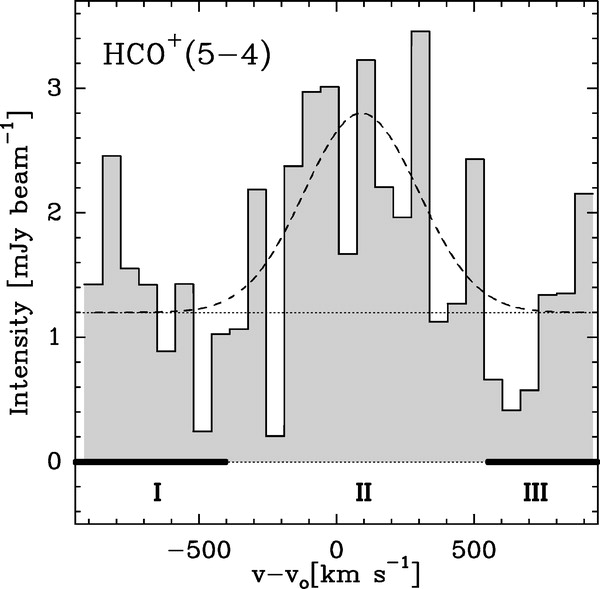
|
A new probe of dense gas at high redshift: detection of HCO+(5-4) line emission in APM 08729+5255
S. García-Burillo, J. Graciá-Carpio, M. Guélin, R. Neri, P. Cox, P. Planesas, P. M. Solomon, L. J. Tacconi, P. A. Vanden Bout,
Observatorio Astronómico Nacional, (IGN, MFom), Madrid, Spain
The quasar APM 08279+5255 at redshift z=3.91 is one of the most
luminous sources in the universe and, therefore, is the right object
to study the role of the molecular gas in the processes of star
formation and nuclear activity at high redshift. The detection of HCO+
J=5-4 emission based on observations conducted at the IRAM Plateau de
Bure interferometer is a step forward in the knowledge of the role of
dense molecular gas in star formation. In fact, multi-species
observations of molecular lines are an essential tool to study the
processes that produce the high luminosity of ultraluminous infrared
galaxies in the local universe and of sub-millimeter galaxies at high
redshift that are currently being probed by molecular lines using the
IRAM telescopes.
This is the first
detection of HCO+ at such a high redshift. Its intensity is
only 4 times weaker than that of the CO J=4-3 line measured towards
this object (Downes et al 1999), therefore it is several times
stronger than what is found in nearby starburst galaxies. The HCO+
line characteristics are consistent with those derived from the HCN
J=5-4 line emission in this quasar recently measured also at Bure
(Wagg et al 2005), what suggests that both emissions come roughly from
the same region surrounding the active galactic nucleus (AGN). However
the similar intensity measured for both lines was unexpected as it was
not predicted by simple radiative transfer models under the hypothesis
of collisional excitation and similar chemical abundance. Infrared
pumping of both lines around the AGN is one of the possible
explanations, but observations of additional transitions of these and
other dense molecular gas tracers will be needed to explain the
characteristics of the gas and of the excitation of the lines that
leads to their high intensities.
For more details see astro-ph/0605656 (ApJL in press)
|
|
PR 0413/06
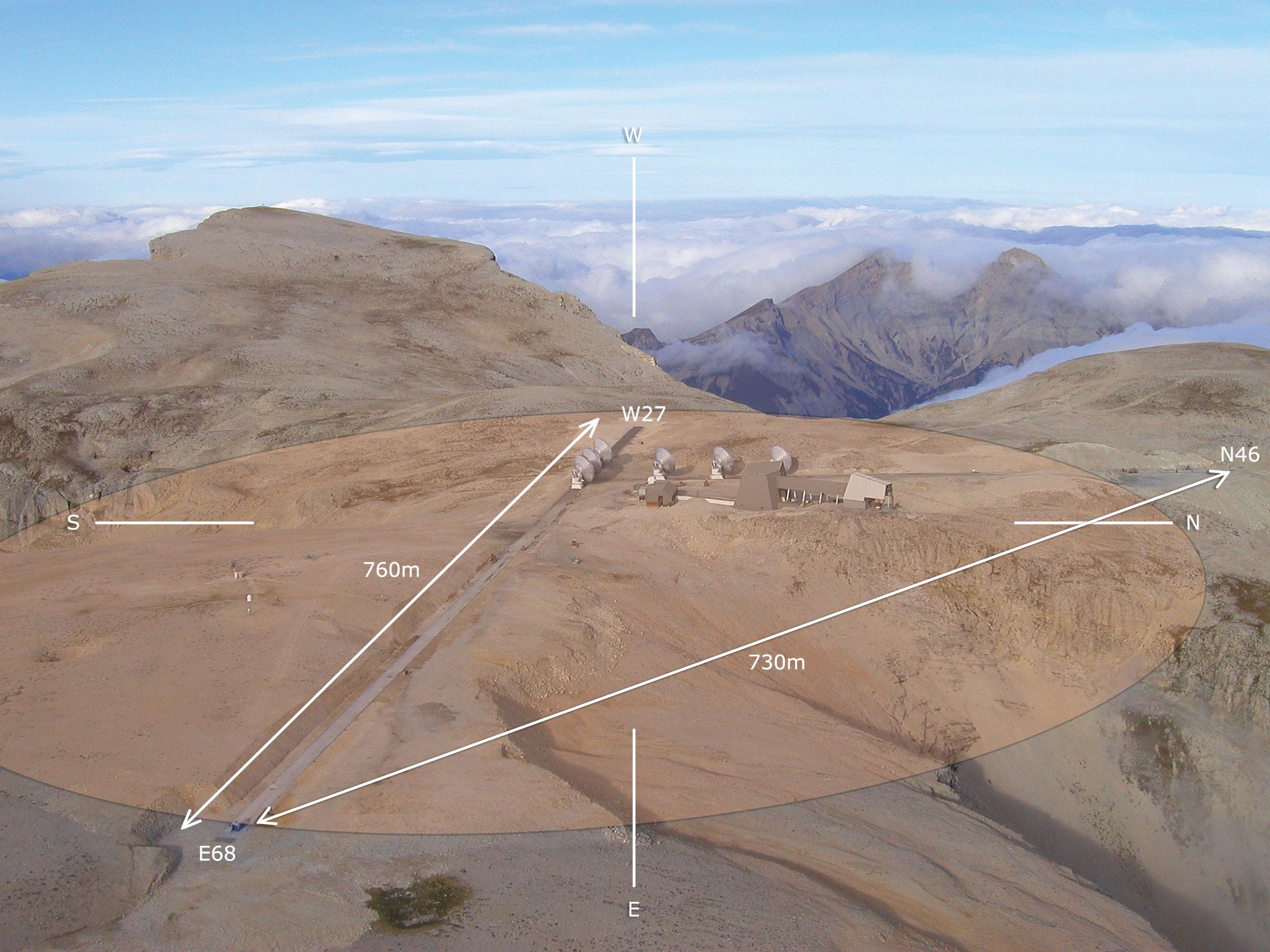
|
The Plateau de Bure Interferometer Gets a Sharper View!
The beginning of the year 2006 was highlighted on Plateau de Bure by
moving the array for the first time into the new extended
A-configuration. The change of configuration was accomplished on
Friday, 13th January 2006 in less than one day, thanks to excellent
weather conditions and a perfect preparation of the tracks. A few
hours later fringes were obtained on the new baselines and shortly
after a baseline solution with excellent precision. The first
scientific project was successfully observed in the new A
configuration the following morning, again under excellent atmospheric
conditions and on January 24th already 14 tracks have been completed.
More ...
|
| |
To visit the page of less recent results, please go to the
archive.
|
